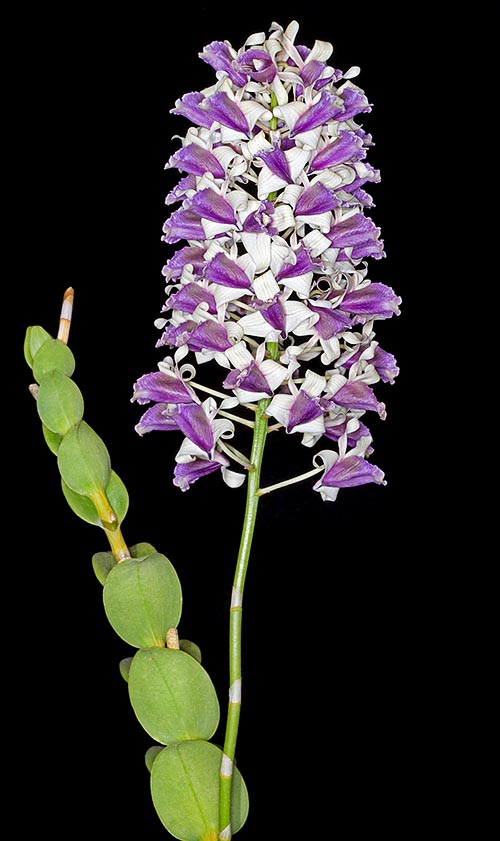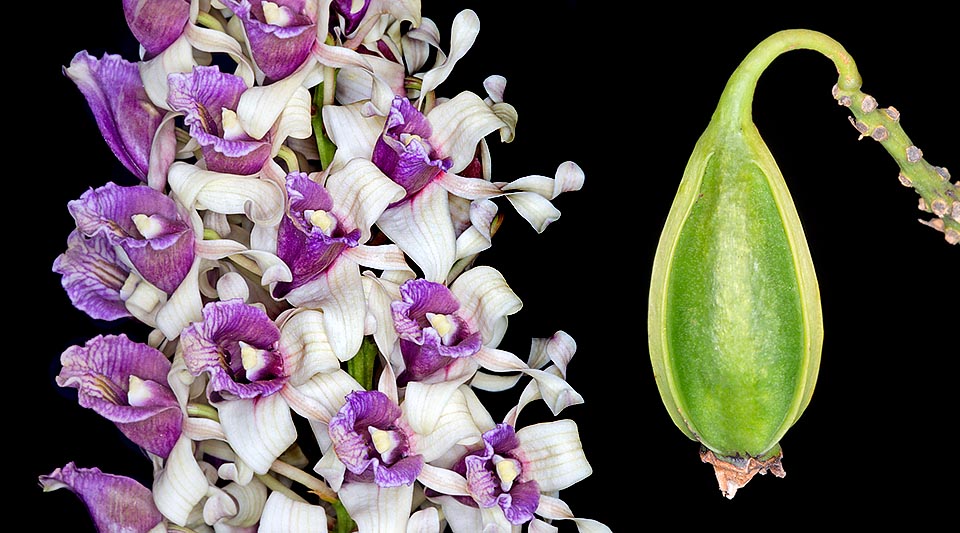Family : Orchidaceae

Text © Pietro Puccio

English translation by Mario Beltramini

Dendrobium nindii is a rare species in nature and in cultivation, at home along water streams of Queensland and New Guinea humid forests © Giuseppe Mazza
The name of the genus is the combination of the Greek substantives “δένδρον” (dendron) = tree and “βίος” (bios) = life, with reference to the numerous species of the genus living on the trees; the species is honoured to the English administrator and explorer Philip Henry Nind (1832-1896).
Common names: blue antler orchid, blue orchid, cowslip orchid (English).
The Dendrobium nindii W.Hill (1874) is an epiphytic species wth cylindrical pseudobulbs thinned towards the apex, erect, usually of 0,5-1,5 m of length, and of 1-2 cm of diameter, but which in nature may exceed 2,5 m, provided in the upper part of alternate distichous ovate-lanceolate, 5-13 cm long and 2,5-4 cm broad, coriaceous, dark green, leaves.
Erect racemose inflorescences, on long peduncle, from the upper nodes, 20-45 cm long, carrying numerous close together flowers of 4-6 cm of diameter, with twisted sepals and petals of white or pale violet colour and violet labellum.
Oblong sepals with obtuse retroflexed apex, 3-4 cm long and 1,2-1,8 cm broad, the lateral sepals, merged at the base of the column, form a sort of a conical, long about 1,5 cm, spur (mentum); linear twisted petals, 3,5-5 cm long and 0,5 cm broad, trilobed labellum about 4 cm long and 3,2 cm broad, run by three parallel purple lamellae, wide lateral lobes on the sides of the column, oblong median lobe with undulated margins and pointed apex, 0,5 cm long and 0,8 cm broad.
It reproduces by seed, in vitro, and division, to be done by the vegetative restart, with each section provided of at least 3-4 pseudobulbs.
Species rare in nature and in cultivation with attractive perfumed and long lasting flowers, about one month, requires high luminosity for blooming, medium-high temperatures from spring to autumn, averagely cooler in winter, with lowest night values not under the 15 °C, high humidity, 70-80%, and constant ventilation.
The waterings must be regular and abundant during the whole period of growth of the pseudobulbs, rather spaced during the vegetative stasis. For the waterings and nebulisations is to be used rainwater, from reverse osmosis or demineralised; the fertilizations, duly distributed in way to avoid salts accumulations, are to be done during the vegetative period preferably with hydrosoluble products, with microelements, at ¼ of the dosage suggested on the package.

It's an epiphyte exceeding the 2 m with 20-45 cm inflorescences. Left, 4-6 cm flowers close-up and, right, ripening fruit © Giuseppe Mazza
Synonyms: Dendrobium tofftii F.M.Bailey (1890); Dendrobium jofftii T.Durand & B.D.Jacks. (1902); Dendrobium ionoglossum Schltr. (1912); Durabaculum ionoglossum (Schltr.) M.A.Clem. & D.L.Jones (2002); Durabaculum nindii (W.Hill) M.A.Clem. & D.L.Jones (2002); Durabaculum pomatophilum (Schltr.) M.A.Clem. & D.L.Jones (2002).
→ For general notions about ORCHIDACEAE please click here.
